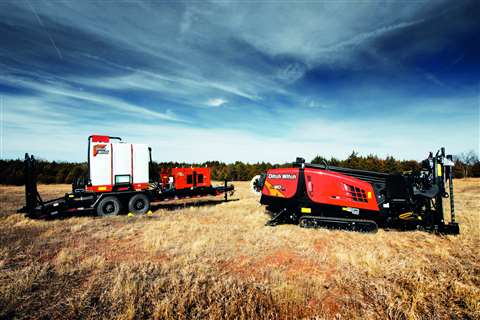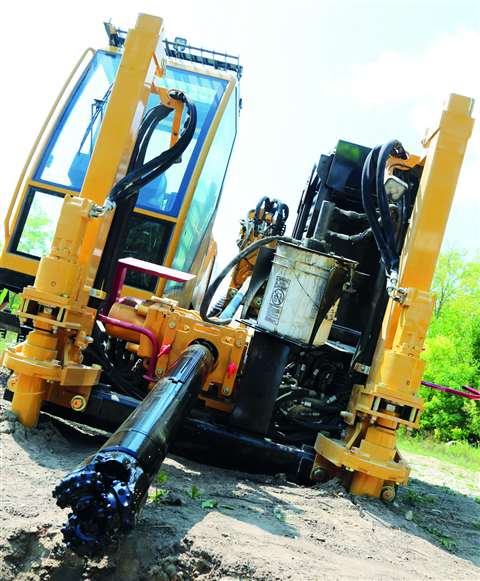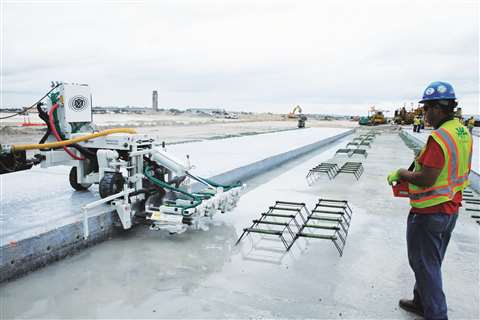Drilling: Knowing the drill
01 May 2019

With diverse applications and a huge variety of equipment and components, drilling can be a difficult sector to pin down.
Yet, its importance to the construction and quarrying industries is undoubted, as the strength of the offerings from major manufacturers demonstrates.
Trenchless technology is now a prerequisite on many construction sites, and the power and durability of horizontal directional drilling (HDD) equipment is advancing, along with guidance system technologies.
Ditch Witch recently launched two directional drills. The first was the JT20XP directional drill package, designed for mid-sized and larger utility-installation jobs.
Along with the drill itself, the package includes an XP44 mixing system, which channels all 118 hp of on-board power towards thrust and rotation.
Powered by a 74.5 hp Tier 4 Deutz diesel engine, the new drill promises greater mud flow, plus improved spindle torque and speed than its predecessor.
The mixing system is powered by a 44 hp Tier 4 Yanmar diesel engine.

Ditch Witch says the compact nature of the drill package allows for easy transportation in and around job sites.
The unit includes ergonomic controls, an LCD display and electronic strike indicators.
Ditch Witch’s JT40 directional drill, which is available with an optional fully-enclosed cab, has a choice of heat and air capabilities, or an open operator’s station.
Both options feature an ergonomic seat and extended legroom and place the operator at a 45-degree angle, which Ditch Witch says provides visibility at all critical vision points.
Powered by a 160 hp, Tier 4 Cummins diesel engine, the JT40 promises minimal pipe-entry distance, resulting in extra drill pipe support on entering the ground. Ditch Witch says class-leading cycle times can be achieved due to the drill’s optimised carriage speed, while its ability to hold up to 182.8 m of drill pipe onboard allows for extended bores.
Enhanced productivity
Vermeer recently introduced the D40x55DR S3 Navigator HDD, designed to deliver enhanced productivity across a range of ground conditions. The drill features the company’s dual rod technology, with an inner rod providing torque to the drill bit, while the outer rod aids steering and rotation torque for reaming. Together, says Vermeer, the two enhance downhole cutting, while the machine offers the flexibility in terms of tool selection, appropriate for the ground conditions.
Tod Michael, product manager of trenchless products at Vermeer, said, “Dual rod drilling rigs are much easier to use than other rock drilling solutions and provide more versatility when a contractor is drilling soil conditions that vary significantly throughout the bore path.
“With the D40x55DR S3 horizontal directional drill, we’ve incorporated the dependability and performance of our popular D40x55 S3 Navigator horizontal directional drill with the latest advancements in dual rod technology to create a familiar operator experience that will outperform many other rock drilling solutions.”
Vermeer says the time required to add or remove a rod on the new drill has been cut by 30%, compared with earlier models. A wide range of tooling options are also available, including rotary, drag cutting and roller cone bits, plus air hammers and the ability to pull larger hole openers.
The drill is powered by a 104.4 kW (140 hp) John Deere diesel engine, and boasts thrust/pullback of 177.9 kN, plus 7,457 Nm of rotational torque. The rig can carry 152.4 m of drill rods onboard and promises a low sound power rating of 104 dBA.
Vermeer has also released a new tooling option for its range of dual rod directional drills – the RH15 rock drill head, which was developed in conjunction with the D40x55DR S3. The drill head is designed to cope with 2,033.7 nM of inner rod torque, which the company says allows operators greater steering control. It also has an advantage in that it can be rebuilt in the field.

Another new development in horizontal drilling is Tracto-Technik’s new generation of Grundodrill horizontal mud drilling rigs.
The six-model series ranges from 60 kN to 280 kN, with the machines incorporating a modular design, allowing users to configure the rigs according to their individual requirements.
The Grundodrill range features increased rotation power and drilling fluid capacity, combined with high drive power, allowing the rig to be adapted to suit different geologies.
Throughout the classes, the rigs can be used as jet condition systems (JCS), with normal rods, for conventional soils, or as all condition systems (ACS), with twin-tube rods, suitable for complex geologies and rocks.
In terms of the onboard technology, the Grundodrills are controlled via a central touchscreen, allowing for extensive automation and remote-controlled drilling. An integrated camera also provides the operator with an overview of all relevant areas of the drilling rig.
Where large drilling areas are required, in hazardous conditions in both construction and quarrying, surface drill rigs often provide an appropriate solution.
Increased mobility
Sandvik says it developed its new non-cabin Ranger DXR series of surface top hammer drill rigs in response to customer requests. The two non-cabin rigs are the Ranger DX600R and DX800R.

As with the original DX series, the new rigs have a drilling coverage area from 17.6m2 to an optional 26.4m2, but are lighter and more mobile and designed for conditions requiring advanced radio remote-control capabilities.
According to Sandvik, the DXR rigs can be used on unstable benches and deep cuts, which are typical to applications such as road and railroad construction, foundation drilling, trenching and pipeline contracts.
The revolving superstructure, with a new counterweight solution, offers enhanced drilling coverage and aids stability, making for a more solid foundation on difficult terrain.
The revolving superstructure on the DXR machines, along with their Rock Pilot+ drilling control systems promise productivity gains of up to 60% over conventional top hammer drill rigs.
The new Ranger rigs have a hole size range of 64 mm to 127 mm, with drill rod sizes between 38 mm and 51 mm, but the configuration of the machine can be boosted with more than 30 options, including an extended superstructure turning radius, advanced measurement systems and upgraded dust control.
On the subject of dust control, TEI Rock Drills produces a range of dust suppression systems that inject water into the drilling air, reducing particles around the drill hole.
The TE10851R system, for example, is equipped with either a 189 litre or a 379 litre water tank, offering suppression for up to eight hours, depending on the size of Hand-held drills are still important, on construction sites, at roadworks or for quarrying and mining applications.

The traditional pneumatic rock drill has been the standard for decades, but Hycon has developed a hydraulic alternative, the HRD 30 Rock Drill, available from August this year.
Hycon says the new drill offers enhanced precision, performance and power, as well as the benefit of lower emissions. However, it could be the ease of transport that attracts contractors and rental companies to the hydraulic solution.
Hycon CEO Martin Møller says, “Conventional rock drills require large and heavy compressors to operate them. These compressors can only be towed, so if you also need to take a excavator to the worksite, you’ll most likely need to make two trips. Using hydraulics, you can transport a compact power pack in the truck, or even use the excavator’s own hydraulics to work the drill.”
In developing the new drill, Hycon made minor modifications to its hydraulic saw motor, adding an air-driven flushing system for removing debris from the drill hole. The tool’s built-in compressor delivers high airflow at low pressure.
Hycon says the HRD 30 is ideally suited to drilling deep and large-diameter anchoring holes, as well as blast or splitting holes, measuring between 25 mm and 50 mm.
The company says its precision drilling makes it suitable for non-dynamite destruction solutions, such as expanding smoke cartridges or an expanding cracking agent (Bentonamit).
Møller says, “In Sweden, one of the testing contractors was able to create nicely rounded holes that were very straight and far closer to the desired tolerance than a pneumatic drill can achieve. If you’re putting in an anchor bolt for a power mast, for example, you really need that sort of accuracy.”

As a ready-to-operate package, Hycon says the new HRD 30 rock drill is particularly suited to utility roadworks such as traffic signage, barrier erection or gas detection. The low weight of the drill and power pack offer benefits in the erection of power masts or antennas on mountaintops, negating the need to potentially airlift in a heavy air compressor.
tools and techniques
Klemm Bohrtechnik – part of the Bauer Group – recently unveiled the extra-long drill mast version of its KR 805-3G universal drill rig, specifically developed for applications such as soil nails, augers or casings for drill depths of up to 6 m, using the single-pass method.
With an optional swivel magazine, Klemm says the drill depth can be extended by a further 6 m without the need for manual reloading. The drill string magazine can also be adjusted to drill tools with a usable length of 3 m, using flexible positioning of the upper grab system. In this way, the magazine can hold drill tools with a diameter of up to 152 mm and 6 m or 3 m in length.
The rotary drives and hydraulic hammers are matched to the drill rig and drives are operated with a system pressure of 310 bar.
The kinematics enable the mast to reach drill points perpendicular to the crawlers at angles between 0° and 90°. The mast can also be positioned to drill vertically beside the tracks.

With the drill mast, Klemm says it is possible to reach drill points up to a height of approximately 4500 mm, which is an advantage in slope stabilisation work.
The rig has a 129 kW Volvo Penta diesel engine, which complies with EEC 97/68 EC Stage 4 regulations.
The hydraulic system operates with two load-sensing main pumps, each with a displacement of 190 litres/min and a pressure level of 350 bar. The optimum power level is automatically adjusted by the Energy Efficient Power System (EEP), and Klemm says fuel consumption is reduced by up to 25% compared with machines of the same power class without EEP system.
The new KR 805-3G rig has a 14.5 cm touchscreen and, in the event of an error, a detailed diagnosis can be carried out via the display.
In standard practice, the KR 805-3G is operated using a portable wireless remote control, although an optional fixed control arm is also available. Minnich Manufacturing, a US-based manufacturer of concrete dowel pin drills, concrete vibrators and vibrator monitoring systems, has an extensive line of drilling equipment, including the A-4SCW.
Going wireless
Minnich’s A-4SCW on-slab self-propelled wireless units increase drilling efficiency, accuracy and safety. Wireless remote-control technology enables operators to drill up to five holes at once and drive down the slab to drill the next set of holes — all while standing in the grade way from the equipment. From this clear vantage point, operators can drill faster and more accurately while avoiding dust, debris and obstacles.
Power crab steering further boosts efficiency by letting operators drive down the slab without raising and lowering the drill bed. The drill distance from the top of the slab is anywhere from 3.5 inches to 12 inches.
At a service weight of 3,260 pounds, the A-4SCW has a maximum hole depth of 18 inches and maximum cutout width of 48 inches. The unit features drills that automatically retract and shut off when the hole depth has been reached. The automatic shut off feature helps to minimize dry firing, which can lead to increased maintenance and a shorter drill lifespan.
Minnich’s dust collection system can be added to the A-4SCW to maximize operator safety and comply with the new Occupational Safety and Health Administration (OSHA) silica dust rule. Featuring Venturi-style suction and manual or automatic purge control, the pneumatic Minnich dust collector prevents dust from entering the air as the operator drills. Each canister-style unit can accommodate up to two drills and offers a 60-square-meter filter area.
“Silica dust collection is an example of an extra step contractors now take to assure the safety of their workers and the public,” said Rob Minnich, president CMO for Minnich Manufacturing. “Minnich offers products — such as a dust collection system for dowel pin drills — that provide solutions for job-site needs.”
Drilling into technology

Groundworks software from Trimble has auto stop, reducing overdrilling
Trimble has launched its Trimble Groundworks Machine Control System for drilling and piling operations.
Scott Crozier, general manager for Trimble’s Civil Engineering and Construction Division, says, “Contractors can achieve centimetre-level accuracy with stakeless navigation, which reduces rework and decreases the need for personnel working near the machine during operation.”
The system, says Trimble, allows operators to precisely drill to the specified location, depth, orientation and inclination angle required. Drill hole spacing and the location of the drilling rig can be optimised, so a more even blasting pattern can be achieved, leading to improved rock fragmentation and, potentially, lower haulage costs.
The software includes an auto stop feature which stops the drilling procedure at target elevation, reducing overdrilling to prevent machine wear.
Trimble says its Groundworks system minimises the need for stakes and surveying, therefore promoting jobsite safety with fewer people working near the drilling machine.
Using the technology, machines can operate 24 hours a day, 7 days a week and in almost any conditions.
A Tiger on the Paris Express

French company Sefi-Intrafor, part of the Fayat Group, is currently undertaking foundation work ahead of construction on the new metro station of Saint-Denis Pleyel in Paris.
The station is one of the first on the forthcoming 16 Line – part of the Grand Paris Express project.
The Sefi-Intrafor is using a Soilmec hydromill SC-135 Tiger to excavate diaphragm wall panels with a thickness of 1.8 m and a depth of 55 m.
The technology onboard the SC-135 includes advanced contaminant protection for its hydraulic system, 90° module rotation and high-precision verticality control, as well as data production via a DMS control system.
The machine’s safety enhancements include an anti-falling system, handrails, ladders and lashing points, while the modular design of the equipment allows for easy and safe maintenance and assembly.
The Tiger’s drilling mate system (DMS) allows for real-time monitoring of operating parameters and the production process, with a dual-axis positioning sensor (or optional triple-axis version) controlling the geometry of the panel, with 2D and 3D graphics print outs.
Drilling made SIM-ple

CM Labs Simulations, developer of Vortex training simulators, has delivered a custom F3500 drill rig simulator to the drill rig manufacturer IHC Fundex Equipment, based in Goes in the Netherlands.
The simulator is equipped with a motion platform and has been fabricated with a genuine F3500 seating and controls system. IHC Fundex’s engineering team is now making use of the equipment as an engineering tool for enhancements as well as a training tool.
The Instructor Operating Station (IOS), a trainee monitoring and assessment tool that automatically captures and reports on operating metrics during training sessions, was also delivered. The IOS allows instructors to select different exercises, time of day and weather conditions, or to inject various machine faults into training sessions, such as pressure faults, filter clogs and coolant over-heating.
IHC Fundex’s Andre Rottier says, “Machines are getting bigger and increasingly complex, and although safety is becoming more and more important, people do not necessarily have as much time to gain experience as in the past. But with a simulator, we can supply training to our clients’ operators — there is a market to sell training to customers all over the world.”
The company’s Anton Hectors says, “Bearing in mind that the real drill rig is not always available, CM Labs’ simulator makes it possible for us to test and iterate more quickly. We can measure time savings in days, not hours.”




